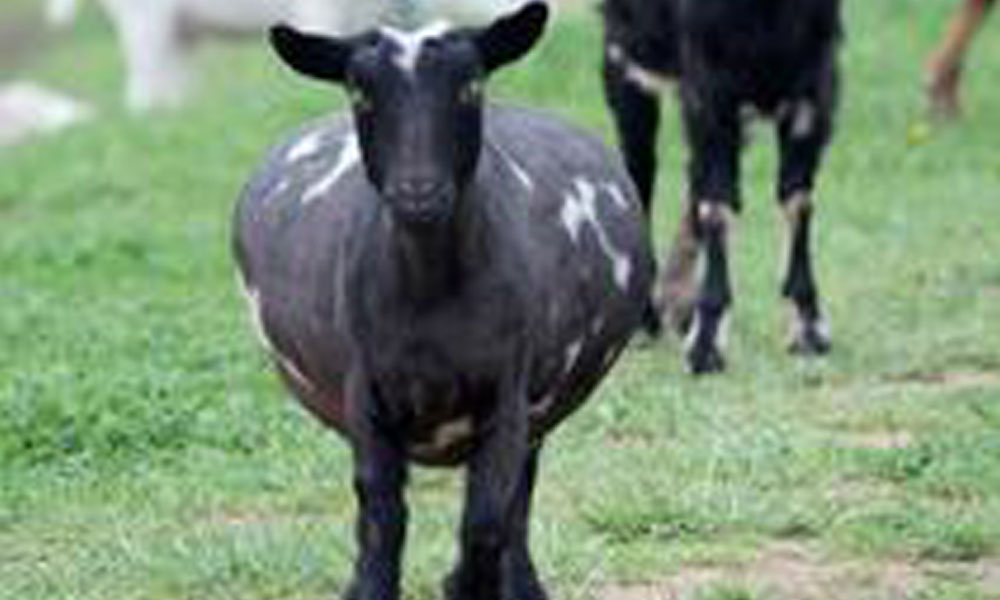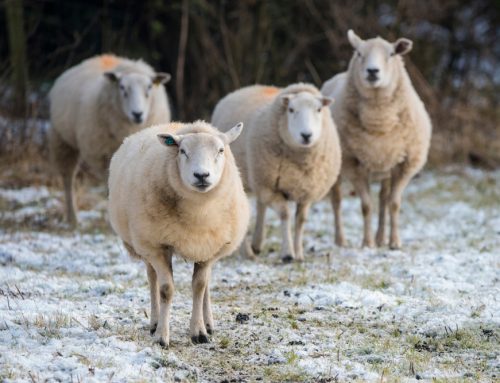Dr. Kathy Thigpin
Also known as pregnancy disease and twinning disease, this disease is caused by the competition for glucose between the doe and her fetuses as they experience rapid growth in the third trimester. It results from a combination of a decrease in the plane of nutrition during the latter third of pregnancy and a sharp increase in energy needs. It can be brought on by short periods of fasting due to such things as showing, vaccinating, or transporting. Stress of sudden winter storms or absence of adequate shelter may be involved as well. Does carrying more than one kid, thin or old does, very fat does and confined does in their last trimester are at most risk. Toxemia may occur as a result of any other condition which decreases feed intake or increases energy needs such as acidosis, water deprivation, low blood calcium, foot rot, pneumonia, heavy worm infestation.
The maintenance of adequate concentrations of glucose (sugar) in the blood is critical to fetal growth, brain metabolism and milk production. However, goats absorb very little glucose from the diet, because glucose is fermented by the bacteria in the rumen. The majority of goat energy needs are met by high carbohydrate-containing feeds. The breakdown products of these feeds are then used by the liver to make glucose which is released into the blood. Excess glucose is stored in small amounts in the liver but this is an inadequate amount for the doe’s needs in late pregnancy. Forage digestion mainly forms fat products not sugars.
When a does in late pregnancy have a sudden demand of energy and/or becomes feed deprived, they begin to break down tissue fats which can be made into glucose but often are made into ketones (like acetone– some of you may be able to smell this on the doe’s breath) and fat is often moved and stored in the liver. These ketones will depress appetite more and the storage of fat in the liver will damage it.. We also see constriction of blood vessels in the placenta which cause the doe to develop high blood pressure leading to kidney failure—this can happen within 24 hours of food deprivation.
Early signs include not wanting to eat, separation from the herd, depression and sometimes blindness. Tremors, chomping of the jaws, foam present at the mouth, a strong sweet smell of acetone on the breath, star gazing, circling, staggering, hind end weakness, head pressing, and muscle tremors and seizures can occur. The doe will becomes profoundly depressed or comatose before dying several days later. Fetal death may occur and sometimes results in a temporary recovery. However, toxicity caused by the dead fetus will eventually cause death of the doe. The length of the disease is often shorter in fat does.
Early treatment may have a favorable result but response to treatment is usually poor, as the disease becomes irreversible in its later stages. Traditionally treatment has been to provide an appropriate energy source and/or reduce the energy drain.
For severe cases an intravenous line and continually giving 5% glucose fluids is ideal but may not be practical. Alternatively, IV catheter can be placed and 50-100 ml of 50% glucose can be given several times a day.
For cases that we can catch earlier we need to
- Attempt to provide glucose precursors by mouth:
- Many small doses of propylene glycol (10 mls) given every 2 hrs over the course of the day is preferable to one or two doses of no more than 30 ml per treatment. Propylene glycol is an appetite suppressant and it inhibits rumen bacteria, so don’t use it unless the doe is truly off feed.
- goat magic (a jump start of energy and glucose for the doe that has not been eating well) recipe has: 2 parts corn syrup, 1 part molasses, 1 part corn oil. Give slowly and carefully by mouth. Some goats suck it out of the syringe
- Energy Malt made by Advanced Agri Solutions. It contains Mega Lac, propylene glycol and niacin. Drench Energy Malt at a rate of 1oz 2-3 times a day. It tastes terrible and they tend to spit it back at you. (Energy drench can be ordered from www.advancedagri.com or by calling 1-800-650-1365
- Nutridrench like propylene glycol (one of the ingredients) but it also contains a variety of vitamins and stuff to stimulate rumen bacteria. 2 ounces twice daily by mouth
- A 500-ml bottle of amino acid-vitamin-electrolyte solution can be given in small doses over a 12-hr period as a drench or added to drinking water. Calf electrolytes for neonatal diarrhea made up according to directions and given orally twice daily for the first day will combat acidosis and dehydration. Some of the glucose in the preparations may even bypass the rumen.
- Low blood calcum can be present in some cases, particularly if grass hay has been the major source of feed. Oral calcium preparations cause burning sensations to mucus membranes and animals generally object when placed in the mouth. One-half cup of calcium proprionatek (approximately 40 gms) mixed with water and given by oral calf feeder twice a day or tube may be helpful providing both calcium and proprionate.
- The B vitamins, especially niacin, are indicated as well as Vitamin E and selenium (25 mg IM). The easiest way to get niacin fast is to use any of the vitamin B injectible supplements. The “super” B has 100mg/ml niacin and also has 100mg/ml thiamine. Give 10cc IM or SQ to down does, alert but affected does could receive it orally – just squirt it in their mouth. You can put it on the feed, but then you don’t know they got it. Niacin is available from feed companies as a premix. Mix the premix grain at the mill so that each finished pound of feed has 500 mg. Walmart has the human niacin supplements tabs, crush them with hammer and topdress grain. Niacin Granules can also be found on line at www.pbsanimalhealth.com
- probios boluses should be used in the anorexic does if they are up and want to eat (but have been off feed due to unforeseen circumstances).
- Removal of the kids by c-section or induction has been used with some success if done in the early part of the disease.
Prevention centers around providing adequate energy to late term does. Heavy, awkward, ponderous does should be separated from those due to kid later and fed separately with plenty of feed-bunk room. A good quality fine-stemmed hay should be saved for these does and they should receive at least a pound of concentrate per fetus per day. Forced exercise by enlarging the distance between feed and water will utilize some of the excess mobilized fats and may be helpful.
A great thanks to all the veterinarians in the Association of Small Animal Practitioners who helped to compile this information.
January 2005







Leave A Comment